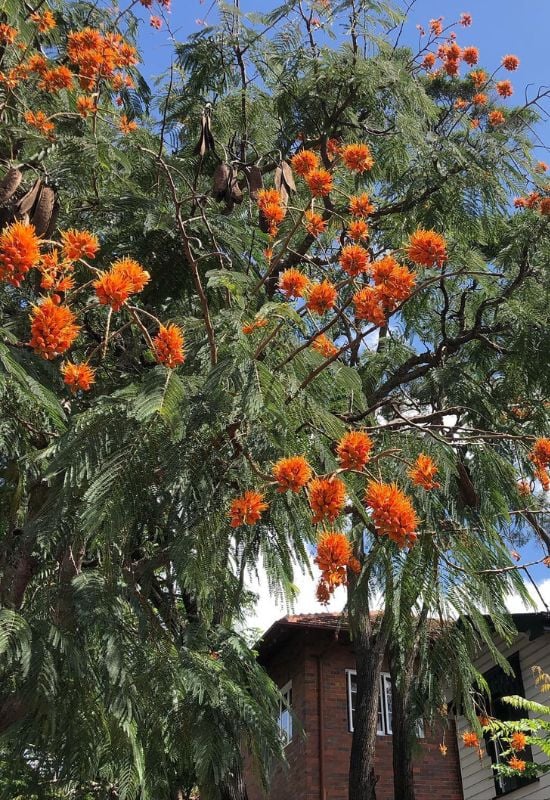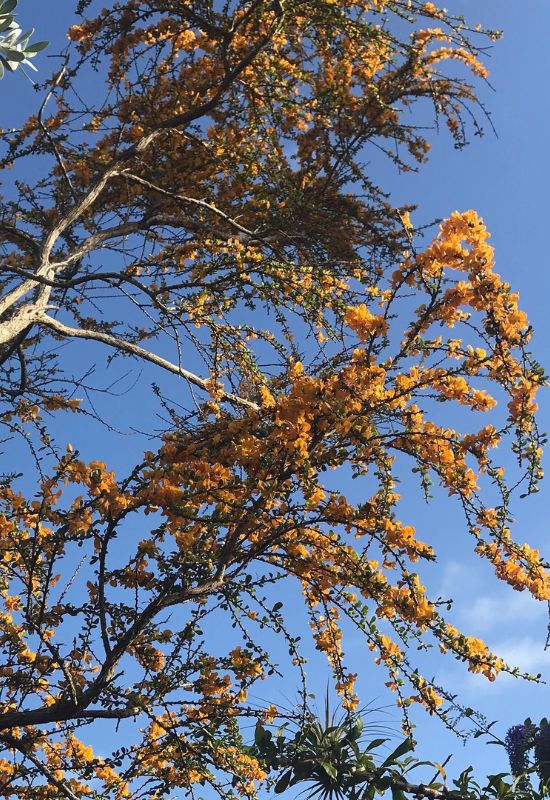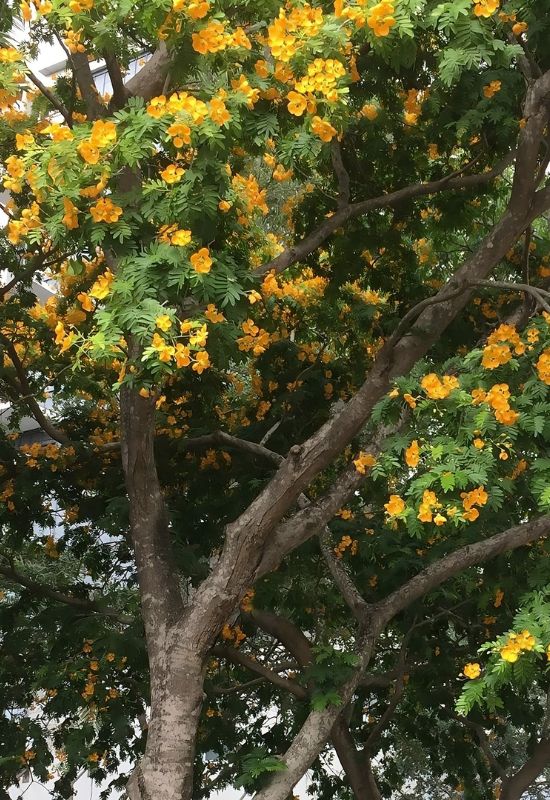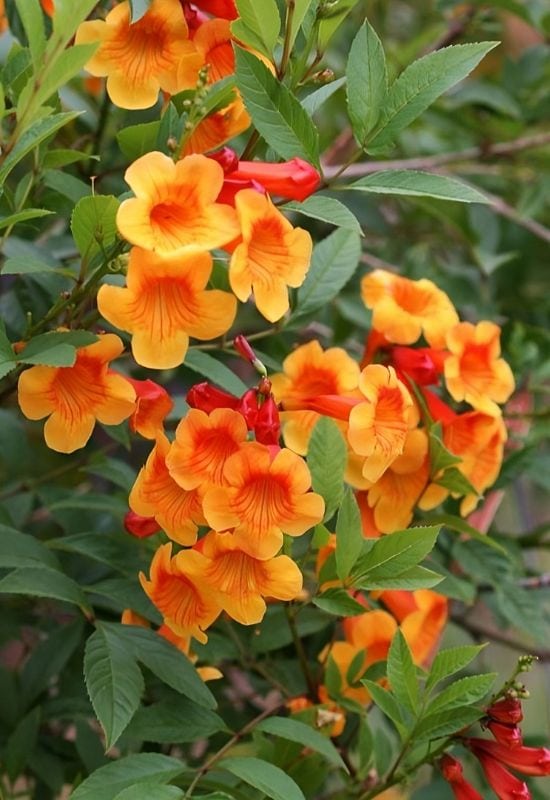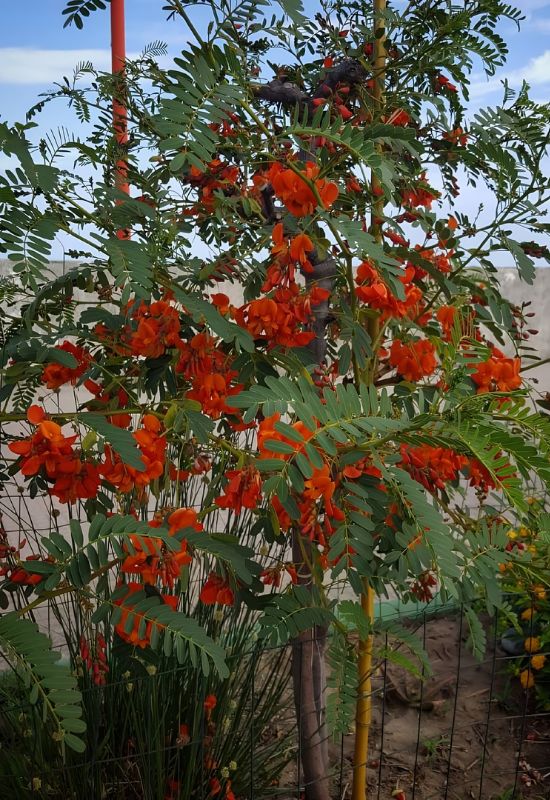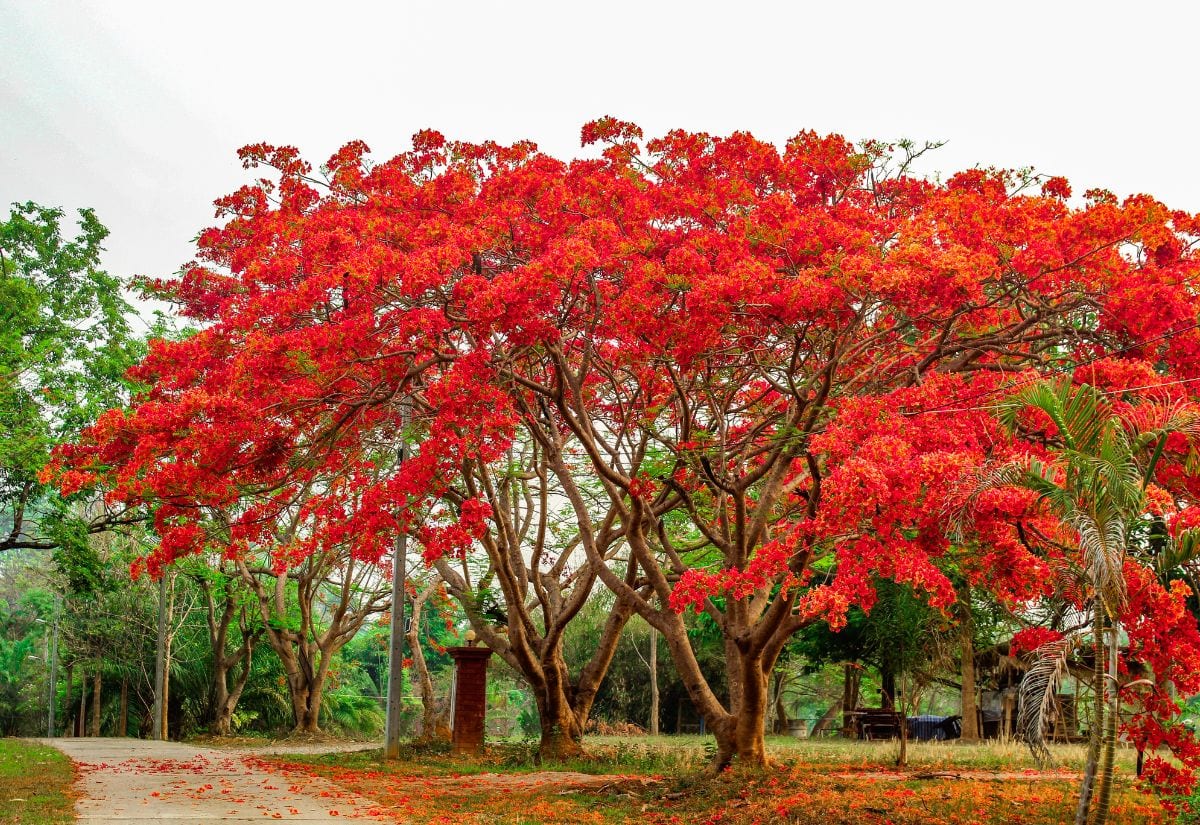
We are going on a flowering journey of light, warmth and energy! Yes, because orange blooms have all these qualities, and if they come on trees… You will see stunning orange blooms open and flourish on top of tall branches, above your head, and and among the leafy crowns that shade and shelter you from the heat… In fact, this color born from sunny yellow and fiery red has both their qualities, and so do flowers in its tonalities…
And trees that bear blossoms in tangerine, carrot, honey or apricot can also add twilight tones to your evenings, or bring the sultry Sun or Mexico down from the sky and into your garden… Whatever landscaping style, there’s one tree that bloom orange flowers ready to grow on your garden, though mainly if you live in a mild or hot country… But not only!
And when you come to the end of this journey, you can pick the trees with orange flowers to the sides of your own paths, or next to your home, to warm up and light up your little green haven!
15 Impressive Orange Flowering Trees
And our journey in the world of orange flowering trees starts right here, meeting the protagonists of this warm and bright adventure.
And the first tree with orange blooms you will meet should give you an idea about what to expect…
Flamboyant (Delonix regia)
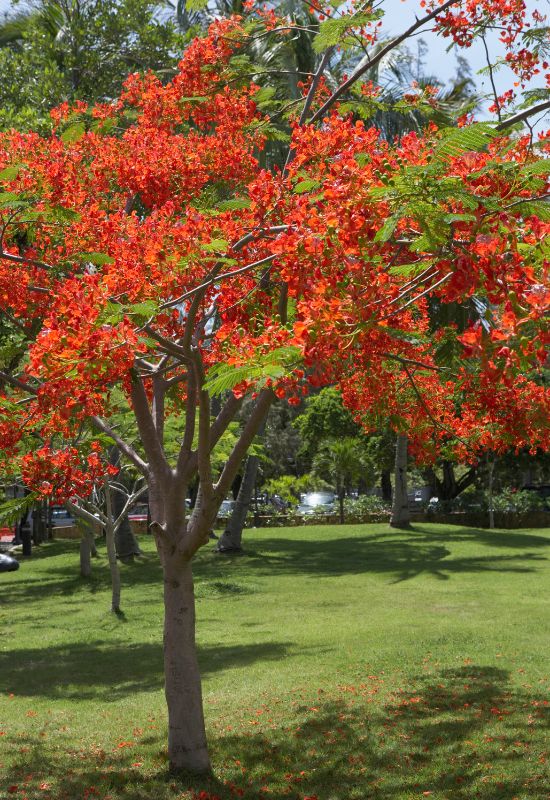
Also called royal poiniciana, flametree and peacock flower, flamboyant is a really impressive orange flowering tree species from Madagascar… When in in bloom, its branches literally fill with show stopping scarlet to fiery orange blossoms, each reaching 4 inches across (10 cm) and in energetic clusters…
They look like orchids, with 5 petals that start off thin and then broad to a fan shape, with frilly edges and one that has a striking and large patch of yellow and white in its petals, with small painted orange dashes on it! The sepals at the back are of the color of oranges too, and they curve backward, forming a star with their long and pointed shape.
Super exotic and long lasting, this incredible floral display is not all you get… Long and flattened seed pods will follow, first in glossy pea green, then ripening to shades of chestnut, sometimes with pink blushes, and then mahogany…
And the foliage is superb! Similar to that of Acacia, the compound leaves have lovely, thin and long leaflets that form fronds to the sides, and give you the most amazing filigree like texture. All this is set on a very decorative, even sculptural umbrella like crown!
You need to live in a hot region to grow flamboyant, which is suitable to Mediterranean and tropical or even xeric gardens. Of course, you will need to find it a very important place on your land, and grow it as an impressive specimen tree! It is really true to its name…
Pomegranate Tree (Punica granatum)
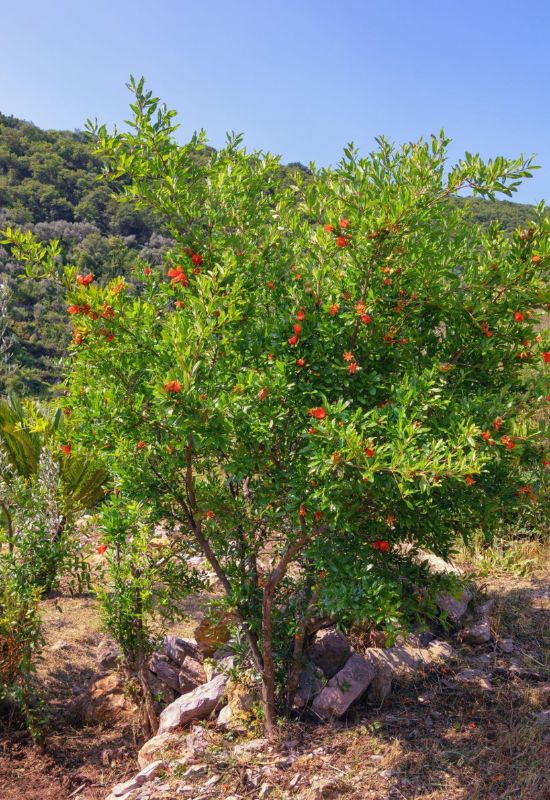
We are talking about the tree that gives us juicy pomegranates, yes! Unlike flamboyant, it will tolerate colder climates, though not freezing, and you can grow it in a large part of the USA, for example… Shrubby by nature, if you cut all the shoots at the base and keep one, it will turn into a lovely small tree!
Its flowers are rally striking, waxy and bell to deep cup shaped, with frilly and glossy petals, about 2 inches long (5.0 cm) and scarlet orange in tonality. Their center is adorned with a florid tuft of butter yellow pistils and and anthers, which attract lots of pollinators.
They will help this native of Southern Europe and Northern India produce the famous fruits, which are very decorative as well as healthy and delicious when they ripen to their brilliant dark red color that shines on the smooth surface… The leaves offer you a fresh and relaxing contrast, bright green small and ovate, quite dense on the branches and evergreen in warm climates.
A classic in Mediterranean and Islamic gardens, pomegranate tree is actually quite easy to grow and low maintenance, and you can grow it in urban and suburban gardens as well. It can also be kept small enough to fit into containers, and in thus case you could have it in cold regions too by sheltering it over the winter season.
American Tulip Tree (Liriodendron tulipifera)
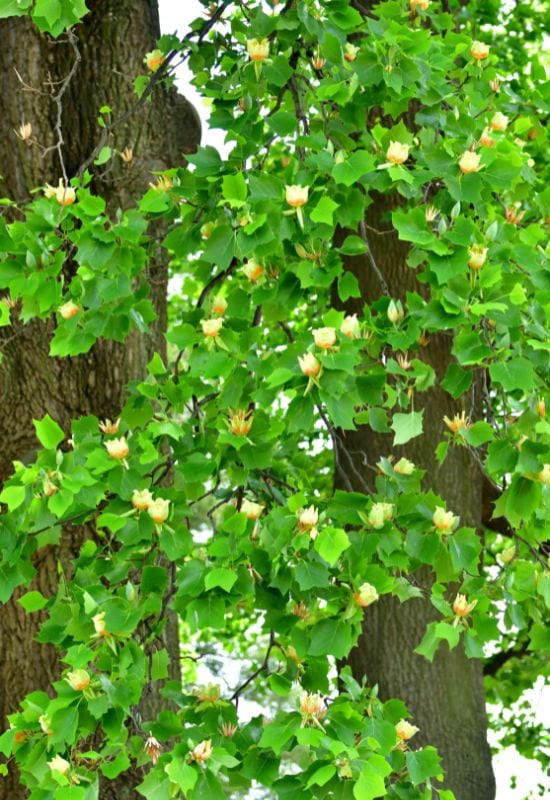
But you don’t need to live in a warm, or even mild country to grow the orange blooming tree of your dreams… Enter American tulip tree, a.k.a. canary whitewood, a.k.a. yellow poplar, a.k.a. many other names… but what matters is that it is very cold hardy! As the name suggests, it comes from the northeast of the new continent, and its flowers look like those the famous bulbous perennial.
The blossoms will appear in late spring, forming cups that reach about 3 inches across (7.5 cm) and look up to the sky from the branches, with a range of shades, but mainly pale and bright candlelight, but with a crown like pattern in darker tangerine right in the middle of its broad petals.
The reproductive organs are quite striking too; the pistils form a ring in the same tonalities, but the cream to lime whitish thick column in the center looks like a short pencil, or an obelisk… They will turn into brown cone like fruits later on in the season.
The dense canopy of glossy, large, deeply lobed leaves, similar to those of plane trees, that brighten to yellow in the fall, and you will understand why it has won the Award of Garden Merit by the Royal Horticultural Society…
Big and showy, American tulip tree will make an excellent specimen plant in any garden, and it is one of the rare orange blooming varieties you can easily grow in temperate looking gardens and in cold regions and wet soil.
Geiger Tree (Cordia sebastena)
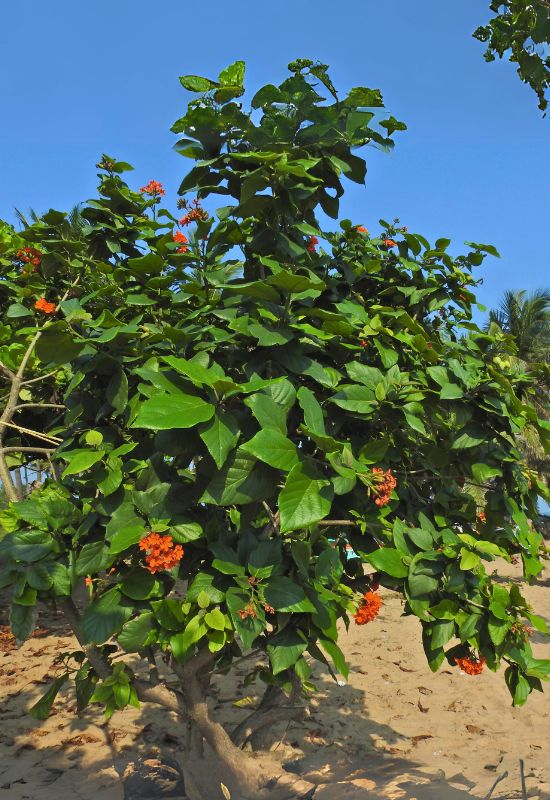
Most varieties with orange blossoms like hot climates, and so does geiger tree – no wonder, since it hails from the West Indies and South America… Then again, it carries the warm, exotic and florid look of those regions to your garden… And it will do it all year round, because its flowering season never ends – literally!
The tips of its branches will keep producing new round and open clusters of blooms, about 2 inches long (5.0 cm), funnel shaped and opening at the mouth to reveal 6 rounded and crinkled petals in a bright and saturated shade of fire orange. Packed with energy, these flowers will give way to egg shaped fruits, white in color and small in size, only 1 to 2 inches in length (2.5 to 5.0 cm).
They smell delicious and they are edible, but they taste very acidic, so, they are best appreciated when cooked or made into jams. The large leaves add to the exotic personality of this tree, heart shaped and large, up to 6 inches long (15 cm) and lush. They are dark green and rough looking on the upper page, but paler and hairy underneath, while the trunk presents a deeply cracked dark grayish brown bark.
Ideal for an exotic looking garden as a specimen plant, geiger tree is not too big, thus suitable for small spaces as well, and, being salt tolerant, it will thrive in coastal regions as well.
Colville’s Glory Tree (Colvillea racemosa)
Here is another very exotic variety with orange flowers from Madagascar and Mauritius, but with a sting in the tail… Yes, because before you grow Colville’s glory tree, you need to be aware that it is poisonous and its pollen can cause allergic reactions… Having said this, it is a real beauty!
What is more, it blossoms in winter, bringing the warmth and energy of tropical summer to your garden when you may need them most… And she does it in style! Its spreading and arching branches will produce long and dense panicles that reach 2 feet long and hang beautifully… The buds are of a bright and vibrant tangerine shape, though they tend to fire and red in some specimens, and they make the clusters look like oddly colored grapes…
When they open, they keep the same palette, but long and fluffy pistils sprout out in thick tuft… This happens at the base (which is from the top), so, it looks like your tree is catching fire slowly… The evergreen foliage is outstanding as well… Frond like and hanging from pale gray branches, the leaves are compound pinnate, arching elegantly with an amazingly fine texture, made up by lots and lots of regularly arranged long and thin leaflets. And all this on a large and done shaped crown that takes your breath away.
An absolutely stunning species, Colville’s glory tree will take center stage in any garden in a hot country… It can work well in exotic or Mediterraneans landscapes but also in urban or suburban ones.
Red Bird of Paradise (Caesalpinia pulcherrima)
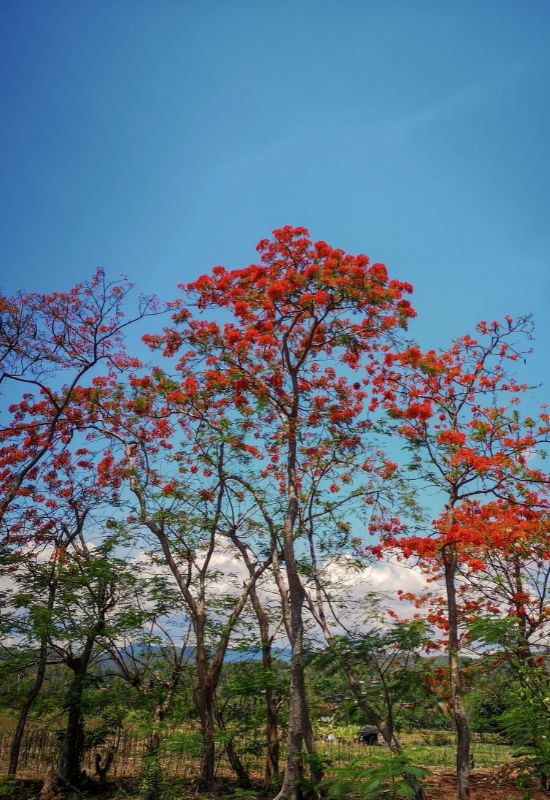
Once again, the energy of Africa and its sunny climate comes to your garden with an orange flowering shrub or small tree, depending on how you train it… And it comes with all the exotic magic of that continent… And all its resilience! Yes, because its floral display last from spring to fall, boasting clusters of up to 40 exotic looking flowers each…
With touches of gold and tangerine, they blush to fiery orange in parts of the petals, that look like the leaves of Gingko biloba, starting off thin to then spread into two lobed fans… From the center, extremely long and arching pistils in the same tonalities and rose or pink extend outwards, like decorative filaments of the 2 inch wide (5.0 cm) flower heads.
All this elegance is enhanced by the very thin stems that hold this display and point to the sky. And the foliage is no less attractive; pinnate and with many ovate leaves, bright green, similar to those of locust trees, the leaves form an open and airy, but also finely textured round crown.
Winner of the Award of Garden Merit by the Royal Horticultural Society, bird of paradise can be an excellent foundation or specimen tree, or, as a shrub, be part of borders and hedges. Ideal for a Mediterranean, oriental or exotic garden, it will keep quite small if you grow it in a container. This way, you can also grow it in temperate and cold climates.
Jamaican Rain Tree (Brya ebenus)
Guess what? Also called granadilla and Jamaican ebony, Jamaican rain tree comes from the West Indies, and this exotic species too has all the livelihood and warm beauty of those regions… So called also because it blossoms during the wet and hot season, it is a distant relative of beans, but it can be a shrub or a small tree… Look at its pea like flowers, and you will be left with no doubt…
The upper petal (the banner) large and it gently bends backward, the side ones (the wings) are small and curving downwards, while the lower one (the keel) is elliptical and you will see a long white reproductive filament resting on it.
The color is on the candlelight to sunrise orange, and the blooms come directly on the thorny branches and they are followed by long and thin seed pods, after a marathon floral display… With arching and descending branches, it will offer you this floral display intermixed with the small, glossy and deep green ovate leaves that persist all through the year, being evergreen. What you will get is a very fine effect of color and sparkling light and darkness games.
Jamaican rain tree will definitely work well in sunny gardens as a foundation plant, but also in hedges or in small groups, as well as in a container or as a bright, energetic but nonintrusive backdrop to your flower beds and borders. You don’t need an exotic garden style for granadilla; any informal design can host it quite well. It is also a great nitrogen fixer, ideal for impoverished soils.
Fragrant Tea Olive Tree (Osmanthus fragrans f. auranticus)
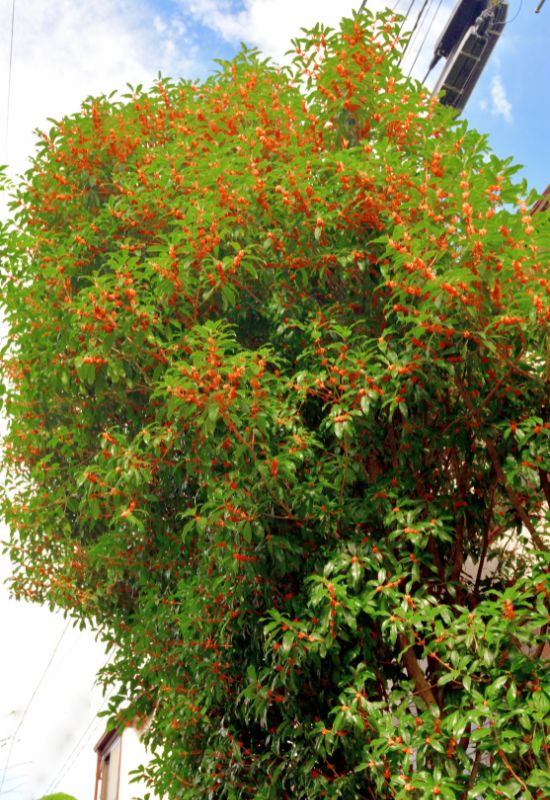
For colder climates, but not very extreme, you can warm and light up your garden with the flowers of fragrant tea olive tree, a species indigenous of the China, Japan and the Himalayas. It will give you its clusters of honey to fire orange, sweet looking flowers in the fall, each head being small, with four petals and waxy, fleshy as well.
Growing on the branches, they all work together to give you a very decorative effect, as they open in great numbers through this season. But this is not all you get with this small tree… And in fact, as the name suggests, the blooms have a pleasant and strong scent, similar to that of apricots.
You can also grow it as a shrub, thanks to its dense branching that starts low down near ground level, and it will still give you lots of leathery, evergreen foliage with a deep and rich tonality of green. The leaves are elliptic and glossy, pointed and much bigger than the blossoms, and they will darken as the months go on.
You can grow fragrant tea olive tree in any informal garden style, including traditional designs, like English country or cottage, but also in more exotic settings… As a shrub, it makes an excellent addition to a hedge, but as a tree, you can mix it with other varieties, have it for foundation planting or even in containers.
Verawood Tree (Bulnesia arborea)
South America gives us another orange flowering wonder, verawood tree, this time from Columbia and Venezuela… While it is actually a small species overall, the blooms are quite bug, between 3 and 7 inches across (7.5 to 18 cm)!
And they have all the exotic flair of their original habitat… Golden to carrot orange in color, they have very original looking petals… They start off very thin and then they widen into wide and spoon like, gently lobed shapes… They look like a creative star, or a propeller of some sort, and don’t expect this spectacle to be short lived… The blossoms keep coming in waves, two to four times a year, all the way from April to October!
This amazing and showy floral display is then followed by impressive winged seeds, that come in pairs, with a snake like mid rib, and they look like some strange flying creatures… The actual seeds inside are quite attractive, on the auburn to brown shade when ripe, glossy and used to make necklaces… The evergreen foliage puts a final touch to this amazing display… hanging like fronds from the spreading branches, the long and pinnate, rich emerald green leaves are finely divided into many elongate and oval leaflets.
Verawood tree is surely yet another species that will need a central place in your garden; elegant and showy at the same time, it would steal the show anyway.
Champak (Michelia champaca)
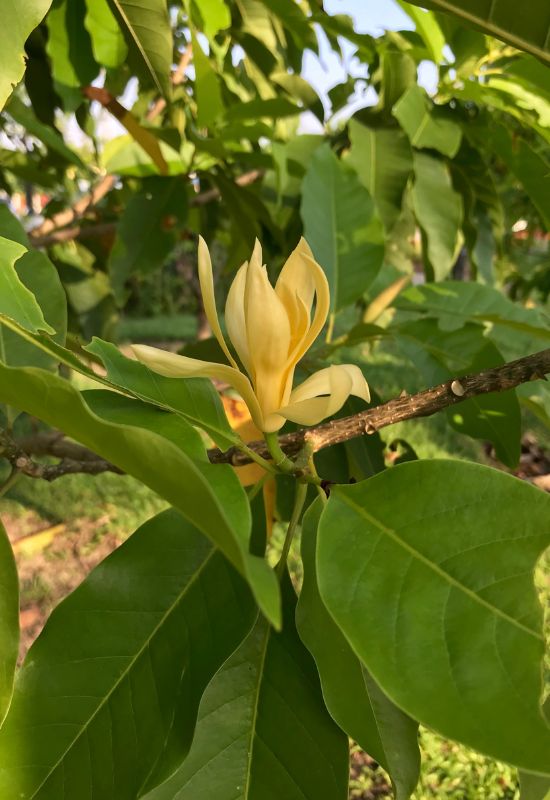
A relative of magnolia, champak is an elegant and showy tree that comes from South Asia and Southeast Indochina. Its large blossoms reach 3 to 5 inches across (7.5 to 12.5 cm) and they have long and spoon shaped, waxy and very glossy petals (tepals). Each flower can have between 6 and 21, usually in 3 to 6 whorls… When it is fully open the flower may look like a many pointed star, but it is beautiful even when in bud…
Again, this is a very generous variety with its floral display, which can last from June to September! And the blossoms will display a range of oranges, starting with lighter tonalities at the edges, with marigold and amber, then intensifying towards the center to hit notes of tangerine, carrot, tiger and even fire!
As it fades, it will take on gentle peach tonalities as well. Having said this, there is also a white variety, Michaila champaca var. alba. Everything about this exotic tree is on a large scale… Growing to become a giant, the evergreen leaves can reach 10 inches long (30 cm), and they are almost leathery, very shiny and deep green, lush on the branches and lanceolate to elliptical in shape.
A magnificent tree with blooms in ana amazing orange palette on a green backdrop, champak will definitely need to be grown as a specimen and accent tree in any garden. Given its close relationship with magnolia (and in fact it is also called “orange magnolia”), it will suit exotic landscaping styles, but also oriental ones.
Orange Silk Cotton Tree (Bombax ceiba)
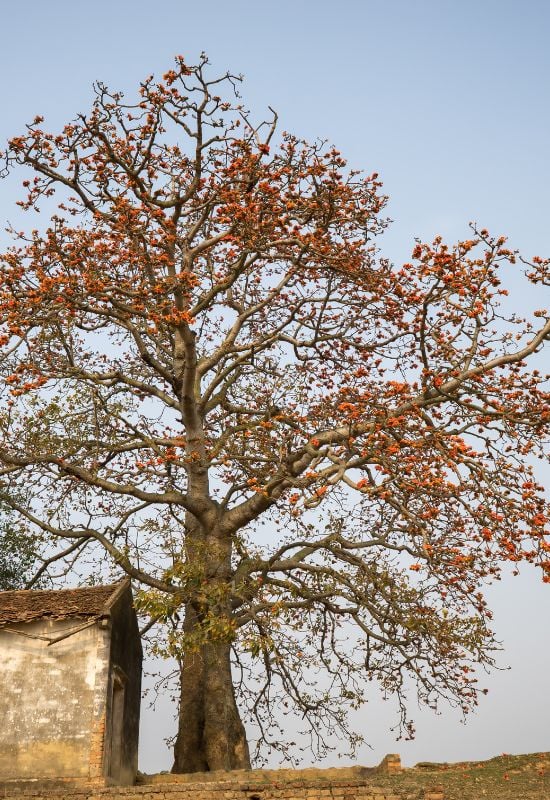
And here is another tropical giant for your garden – which had better be large if you want to grow it… Native of Eastern Asia and northern Australia, it will produce flowers that reach 6 inches in diameter (15 cm), and they are very flashy and waxy… Usually red, there are varieties, or rather specimens, that touch notes in orange, usually paler in the center, where you will also find a lovely ring of pistils. The actual shades will range from bright tangerine to fire and scarlet towards the tips of the 5 petals.
The blooms are held in a coriaceous green calyx in clusters on the branches in spring, and they are followed by a strange event that gives this species its common name… Fluffy and white balls will appear, quite large… These are the seeds, which emerge from canoe shaped and brown seed pods in balls of “wool”… Opening and thinning, they will fall to the ground and spread, so, expect snow in the midst of summer!
The large, deep green and smooth leaves are digitate, forming lovely hand like fronds. And then there is the unusual trunk, with huge and menacing spikes over the grayish bark that stop animals from climbing it.
Ideal for tropical gardens, orange silk cotton tree has become very popular in Mediterranean yards as well. Indeed, you could grow it in other styles too, but always as a towering and show stopping specimen plant.
‘Orange Jubilee’ Esperanza (Tecoma stans ‘Orange Jubilee’)
‘Orange Jubilee’ esperanza is a variety of yellow bells, or trumpetflower, a native shrub or small tree from the West Indies, Texas, New Mexico, Florida, Mexico and South America, winner of the Award of Garden Merit by the Royal Horticultural Society. Just select a main shoot to grow as an upright trunk, and it will give you a lovely round crown on top. And this will fill with lots of showy and trumpet shaped flowers all the way from mid spring to frost!
Each bloom is about 4 inches long (10 cm) and they come in big clusters; at its peak, this exotic beauty will almost totally cover in its generous and long floral display! Opening from glossy crimson to cherry red buds, the blossoms spread to an open mouth with round petals, showing a bright honey to amber orange color striped with darker lines that lead you into the throat, where the tonality reaches notes of fire. Followed by long bean like seeds, up to 8 inches in length (20 cm), that dangle from the branches, the rich and lush green foliage is long, pointed and finely serrated, with a semi glossy and green surface. The leaves will stay on in winter if the climate is warm.
Luckily, ‘Orange Jubilee’ esperanza won’t grow too big, especially in containers. This means that you could grow it even in colder climates, so it can bring its massive tropical and orange blooms to your garden – a look that’s usually the prerogative of Mediterranean and exotic designs…
Flame of the Forest (Butea monosperma)
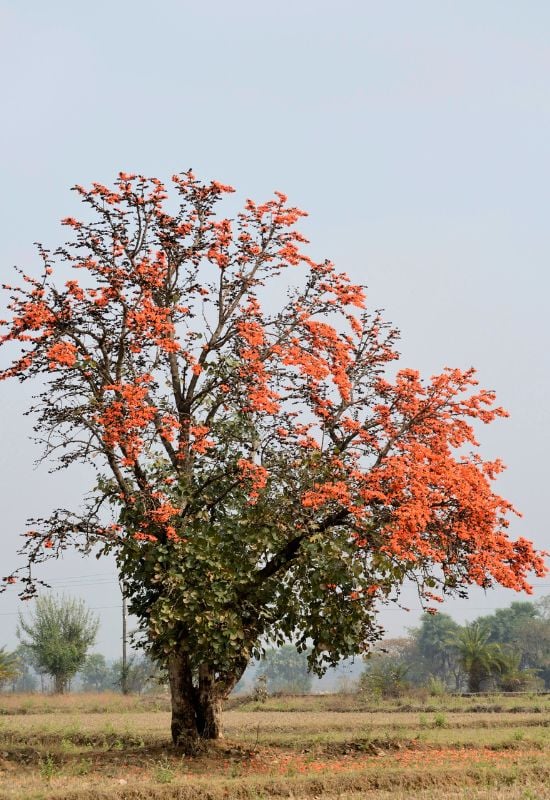
And again, trees with orange colored blooms come back to amaze us with their exotic personalities, and flame of the forest is the living proof. And this time, it comes to your garden from India and Burma, where lush forests light up with its amazing blossoms… And you will be wowed when it explodes with big clusters of flowers that look like parrot beaks…
It will look like someone has set the branches aflame, because the curved petals that cling together in the flowers almost cover the whole crown, which becomes umbrella like in mature specimens. But don’t worry; that amazing flare of fire orange you see is just a massive floral display, even if it starts in the middle of winter… And it will continue into spring!
Each is about 2 inches long (5.0 cm) and they are followed by flat and single seed pods, that start off as green but they mature to bronze shades… Deciduous, the foliage is also quite attractive and lush, with opposite very round and glossy leaves, brighter in spring and darker later on, that will start growing on when the “burning bush” is in the midst of its spectacle. And it is also a holy tree, called dhak or palas in its native countries.
Guess what? Stunning and exotic looking flame of the forest too likes hot climates and it will need an important place in your garden – yet again a species that you can only treat as a specimen and accent tree.
Brazilian Rattlebox (Sesbania punicea)
Also called scarlet wisteria, purple sesbane and false poiniciana, Brasilian rattlebox is a South American native shrub that can easily grow into a tree if you train it, and it will produce an elegant, thin and upright trunk and a lovely umbrella shaped or oval crown. Its many names may confuse you, so, let’s talk about its flowers’ color…
It changes a bit, but it rangers from bright and deep tangerine, energetic through fire orange and it often touches red tonalities, and sometimes it hits notes of rosy magenta… Here is another member of the Fabaceae family, like beans and chickpeas, and it will produce hanging clusters of very showy pea like blossoms, each about 1 inch across (2.5 cm) or a bit more, that descend from the branches and wave beautifully un the breeze.
These beads of energetic blossoms will last for months, all through the summer months and beyond, and they will give way to long, flat, seed pods that start off pale green, turn butter, then chestnut and finally dark brown with purplish reflexes. And the evergreen foliage is just the best setting for all this… Pinnate and frond like, they arch softly with their ovate, bright green leaflets and very fine texture.
Among the advantages of Brazilian rattlebox there are its small size and that it is suitable to mild climates, not juts hot, unlike many other orange flowering trees. You can grow it as an accent or specimen plant, for foundation and in most other roles in any informal garden, or in containers!
African Tulip Tree (Spathodea campanulata)
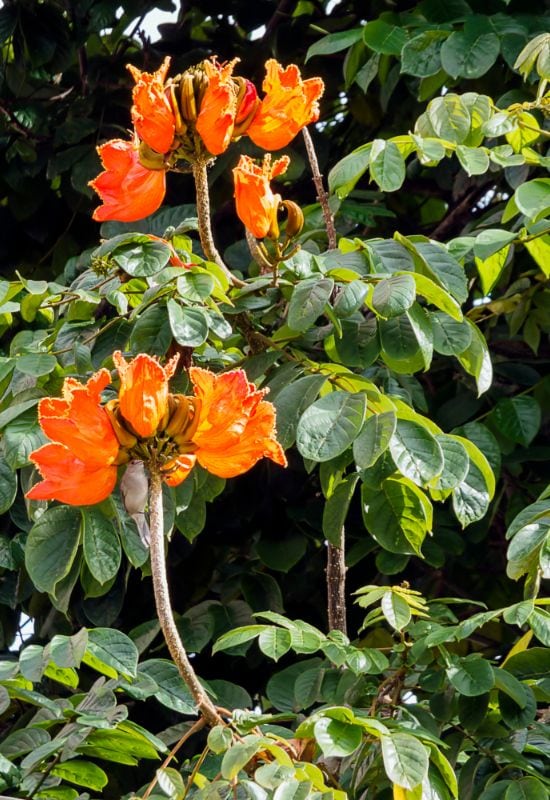
And the final gift from Mother Nature to your garden couldn’t but cone from the sunniest continent of all, and it is African tulip tree. Not related to its American namesake, and it will literally impress you! The flowers come like wreaths, or crowns around a central point, like a wheel on fire.
The buds are parrot beak, or banana shaped, and they will start opening from the outside of this circular cluster. When they do, they will reveal their cupped tulip shape with partly joined margins and crinkled edges. Each bloom can be about 5 inches long (15 cm) and you can see up to a dozen open un each inflorescence.
These blossoms will display colors from yellow to red, including lots of orange. This depends on the specimen, and some are fully within our color’s range, covering the full gamut from pale amber, through tangerine, carrot, tiger and finally fire and scarlet!
Some will even give you a rare peach tonality… these are followed by smooth, long and pointed upright pods, that contain the seeds coated in a fluffy down… Pinnate and very elegant, the evergreen leaves give you a lovely texture and they change from bright to deep green as they mature.
Our last warm, exotic and big orange flowering species, African tulip tree follows the same pattern as most we have seen so far… It will need warm weather and central stage in your garden: it is far too showy and magnificent for anything less…
Orange Flowering Tree for a Warm and Sunny Experience!
And we come to the end of this journey… Orange flowering trees are usually very exotic, but a few can manage cooler climates as well. All, however, have a warmth of their own, and they will heat up your days and garden, even in winter, with their fantastic blooms.

Written By
Adriano Bulla
After many years as an academic in London, Adriano Bulla became a writer, publishing books like A History of Gardening, Organic Gardening and Elements of Garden Design; he then decided to become a gardener, following his childhood dream, and has been following his dream writing and gardening professionally in Southern Europe, where he has specialized in new and innovative organic gardening fields and techniques, like permaculture, regenerative agriculture, food forests and hydroponics.

